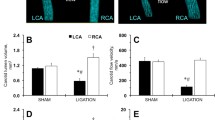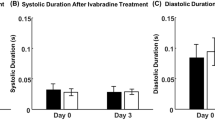Abstract
The study is to establish a novel method to determine the endothelial function in mouse carotid arteries in vivo by using high-resolution ultrasound images. Atherosclerosis in carotid arteries is induced in ApoE−/− mice with a Western diet. The ultrasound of the ventral neck generates clear pictures of the common carotid arteries. Acetylcholine at the range from 5 to 20 μg/kg/min (iv) is able to induce a dose-dependent relaxation as shown by the increased diameter of these normal mouse carotid arteries, which is impaired in atherosclerotic arteries. The endothelial function determined by ultrasound images in vivo matches well with that determined in isolated carotid arterial rings in vitro. All animals survived after the endothelial function measurement. In this study, we have established a standard method to determine the mouse endothelial function in vivo. It is a reliable, safe, and survival method that could be used repetitively in mouse arteries.




Similar content being viewed by others
Abbreviations
- Ach:
-
Acetylcholine
- FMD:
-
Flow-mediated vasodilation
- SNP:
-
Sodium nitroprusside
References
Sima, A. V., Stancu, C. S., & Simionescu, M. (2009). Vascular endothelium in atherosclerosis. Cell and Tissue Research, 335, 191–203.
Mudau, M., Genis, A., Lochner, A., & Strijdom, H. (2012). Endothelial dysfunction: the early predictor of atherosclerosis. Cardiovascular Journal of Africa, 23, 222–231.
Landmesser, U., & Drexler, H. (2007). Endothelial function and hypertension. Current Opinion in Cardiology, 22, 316–320.
Georgescu, A., Alexandru, N., Constantinescu, A., Titorencu, I., & Popov, D. (2011). The promise of EPC-based therapies on vascular dysfunction in diabetes. European Journal of Pharmacology, 669, 1–6.
Higashi, Y., Kihara, Y., & Noma, K. (2012). Endothelial dysfunction and hypertension in aging. Hypertension Research, 35, 1039–1047.
Faulx, M. D., Wright, A. T., & Hoit, B. D. (2003). Detection of endothelial dysfunction with brachial artery ultrasound scanning. American Heart Journal, 145, 943–951.
Lockowandt, U., Liska, J., & Franco-Cereceda, A. (2001). Short ischemia causes endothelial dysfunction in porcine coronary vessels in an in vivo model. Annals of Thoracic Surgery, 71, 265–269.
Mu Zadelaar, S., Kleemann, R., Verschuren, L., de Vries-Van der Weij, J., van der Hoorn, J., Princen, H. M., & Kooistra, T. (2007). Mouse models for atherosclerosis and pharmaceutical modifiers. Arteriosclerosis, Thrombosis, and Vascular Biology, 27, 1706–1721.
Jawień, J., Nastałek, P., & Korbut, R. (2004). Mouse models of experimental atherosclerosis. Journal of Physiology and Pharmacology, 55, 503–517.
Chen, X., Zhang, H., McAfee, S., & Zhang, C. (2010). The reciprocal relationship between adiponectin and LOX-1 in the regulation of endothelial dysfunction in ApoE knockout mice. American Journal of Physiology - Heart and Circulatory Physiology, 299, H605–612.
Lesniewski, L. A., Connell, M. L., Durrant, J. R., Folian, B. J., Anderson, M. C., Donato, A. J., & Seals, D. R. (2009). B6D2F1 mice are a suitable model of oxidative stress-mediated impaired endothelium-dependent dilation with aging. Journals of Gerontology. Series A, Biological Sciences and Medical Sciences, 64, 9–20.
Wang, H., Zhang, W., Zhu, C., Bucher, C., Blazar, B. R., Zhang, C., Chen, J. F., Linden, J., Wu, C., & Huo, Y. (2009). Inactivation of the adenosine A2A receptor protects apolipoprotein E-deficient mice from atherosclerosis. Arteriosclerosis, Thrombosis, and Vascular Biology, 29, 1046–1052.
Guo, Y., Zhang, C., Nair, U., Du, X., & Yoo, T. J. (2005). The morphological and functional alterations of the cochlea in apolipoprotein E deficient mice. Hearing Research, 208, 54–67.
Conflict of Interest
None.
Human Subjects and Informed Consent Statement
No human studies were carried out by the authors for this article.
Animal Studies
The work was conducted with the approval and in accordance with the guidelines of the Rush University. All institutional and national guidelines for the care and use of laboratory animals were followed and approved by the university institutional committees.
Sources of Funding
This work was supported by the National Institutes of Health (HL095707, HL109656, and NR013876) to C. Zhang.
Author information
Authors and Affiliations
Corresponding author
Additional information
Editor-in-Chief Jennifer L. Hall oversaw the review of this article
Hua-ting Wang and Zhen Shan contributed equally to this work.
Rights and permissions
About this article
Cite this article
Wang, Ht., Shan, Z., Li, W. et al. Guidelines for Assessing Mouse Endothelial Function via Ultrasound Imaging: a Report from the International Society of Cardiovascular Translational Research. J. of Cardiovasc. Trans. Res. 8, 89–95 (2015). https://doi.org/10.1007/s12265-015-9614-8
Received:
Accepted:
Published:
Issue Date:
DOI: https://doi.org/10.1007/s12265-015-9614-8




